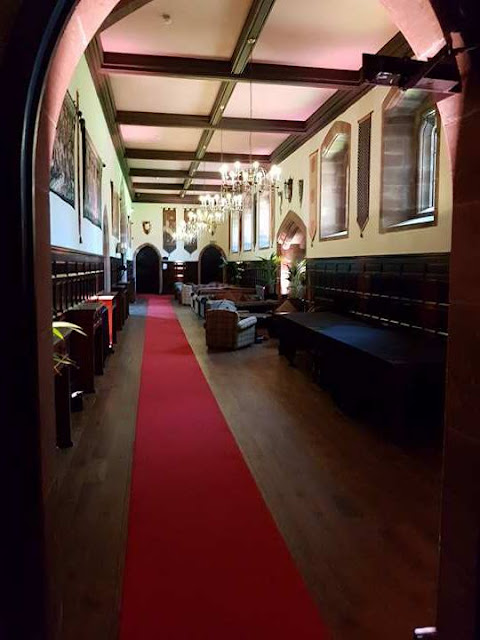
Peckforton Castle Cheshire, The UK.
Peckforton Castle is in the right foreground and Beeston Castle is on the hill beyond
Peckforton Castle was built between 1844 and 1850 for John Tollemache, the largest landowner in Cheshire at the time, who was described by William Ewart Gladstone as "the greatest estate manager of his day". Tollemache's first choice of architect was George Latham of Nantwich, but he was not appointed, and was paid £2,000 (£180 thousand today) in compensation. Instead Tollemache appointed Anthony Salvin, who had a greater reputation and more experience, and who had already carried out work on the Tollemache manor house, Helmingham Hall in Suffolk. The castle was built by Dean and Son of Leftwich, with Joseph Cookson of Tarporley acting as clerk of works. Stone was obtained from a quarry about 1 mile (2 km) to the west of the site, and a railway was built to carry the stone. The castle cost £60,000 (about £5.8 million as of 2017).
Although it was built as a family home its design was that of a medieval castle. It has a gatehouse, a portcullis, a dry moat, external windows that are little more than arrow slots, and large towers. In 1851 The Illustrated London News said that it "seems to exhibit the peculiar beauties of Carnarvon Castle without its inconveniences" and in 1858 Sir George Gilbert Scott called it "the largest and most carefully and learnedly executed Gothic mansion of the present" and that it was "the very height of masquerading". It is regarded as "the last serious fortified home built in England" and "it was executed to the highest standards and is one of the great buildings of its age"
There has been debate about the motives for building a more-or-less complete medieval-style castle in the 19th century. Although he was a great estate manager, Tollemache was also perceived as "a man of considerable eccentricity". Dr Jill Allibone is of the opinion that he might have been protecting himself and his family from the political troubles of the time. In a defensive building he would be able to protect himself against any revolution by the masses from nearby Manchester or Liverpool. A possible practical reason for building such a solid residence rather than an Italianate-style villa was to provide shelter from the adverse weather conditions which could affect the Cheshire plain. However Durdey comes to the conclusion that the decisive factors were to use his "vast inheritance" to provide himself with a house that was "impressive, dominant and suitable for Cheshire's greatest landowner".
Peckforton Castle is a Victorian country house built in the style of a medieval castle. It stands in woodland at the north end of Peckforton Hills 1 mile (2 km) northwest of the village of Peckforton, Cheshire, England. It is recorded in the National Heritage List for England as a designated Grade I listed building. The house was built in the middle of the 19th century as a family home for John Tollemache, a wealthy Cheshire landowner, estate manager, and Member of Parliament. It was designed by Anthony Salvin in the Gothic style. During the Second World War it was used as a hostel for physically handicapped children.
The Tollemache family used the castle for occasional gatherings, but otherwise it was unused until 1969. From 1969 to 1980 the castle was leased by John, 4th Lord Tollemarche to George W. Barrett, and it again became a private residence and closed to the public. The right wing and tower and the castle gardens were restored to their former glory by Barrett, an American employed by the U.S. Government. His daughter Pascale's wedding was the first to be held in the chapel and a special decree had to be obtained by the Archbishop of Canterbury to legally hold catholic weddings in the grounds of the castle.
During the 1970s and 1980s it was used as a location for shooting films and television programmes. The castle was bought in 1988 by Evelyn Graybill, who converted it into a hotel. In 2006 it was purchased by the Naylor family, who expanded its use to include hosting weddings, conferences, and other functions.



















































No comments:
Post a Comment